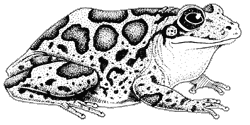Lowland Burrowing Frog
(Smilisca fodiens)
Order: Salientia
Family: Hylidae (treefrogs)
Other common names: lowland burrowing treefrog
Spanish name: rana, sapito
Distinguishing Features

This treefrog reaches 2¼ inches (63 mm) in length and has a tan to light brown dorsum with a dark brown network of blotches and bars and a creamy white underbelly. The toes are slightly webbed and the toe pads are small for a treefrog. The name “casque”, which means helmet-shaped, is given to this frog because the skin of the head is fused to the skull; there is a fold of skin at the back of the head. Males have dark throats and a double vocal sac.
Range
This toad barely enters the United States in south central Arizona but it is common in western Mexico from Sonora to Michoacán. Occurs from sea level to 4900 feet (1490 m).
Habitat
This species inhabits desertscrub to thornscrub. In Sonora this species is more typically found in riparian areas.
Life History
The northern casque-headed frog is insectivorous, terrestrial or fossorial (burrowing), and nocturnal. It breeds from June to September during the summer rainy season. The male’s call is an explosive, hoarse “wauk-wauk-wauk.”
Comments
After burrowing underground, this species sheds several layers of its epidermis that form a virtual “cocoon” around the entire body and probably reduce dehydration in the dry season. In addition, this species uses its head to block the opening to its burrow. This reduces water loss from the frog’s body, and may protect it from some predators.










